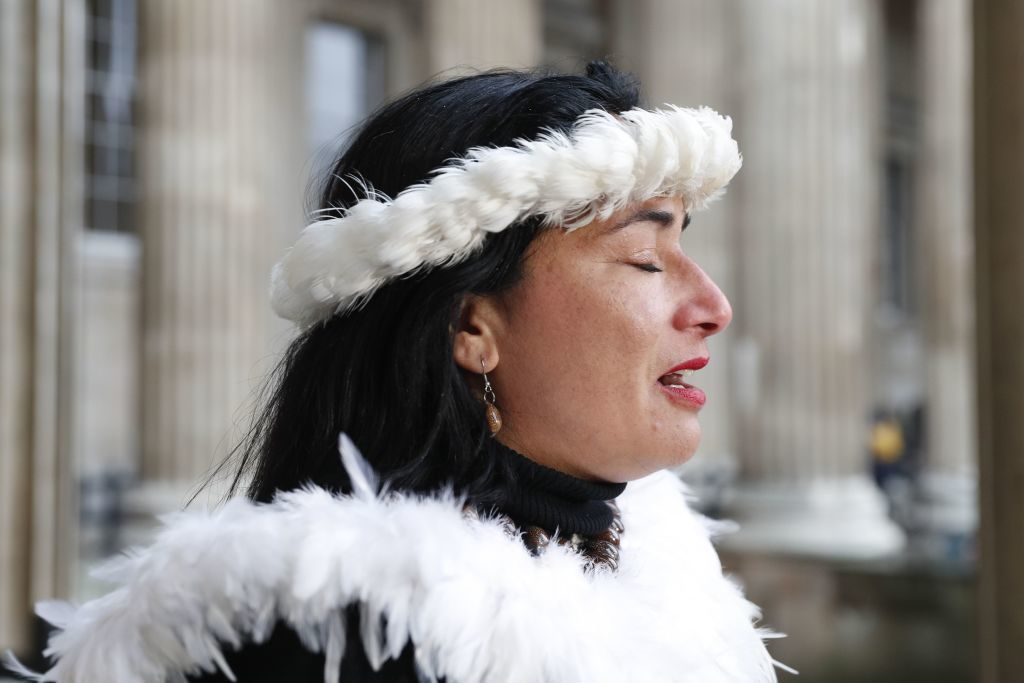Politics
Easter Island’s Mayor Says a Monumental Moai Sculpture Is Better Off in the British Museum
Support for the British Museum coincides with an activist-led tour of "stolen art" that included the sculpture Hoa Hakananai’a.

Support for the British Museum coincides with an activist-led tour of "stolen art" that included the sculpture Hoa Hakananai’a.

Kate Brown

As calls for its restitution grow, the Easter Island’s mayor has said that a monumental statue taken by the British 150 years ago might be better off staying at London’s British Museum.
Pedro Edmunds Paoa says that on the Polynesian island the monolithic Maoi statues are ignored. Referring to the statues still on the South Pacific island over 2,000 miles off the Chilean coast, Paoa said that “[t]hose thousand are falling apart because they are made of a volcanic stone, because of the wind and the rain. We need global technology for their conservation,” according to Reuters. The mayor said that in London, “six million people come each year to visit it” and that he would prefer a financial commitment from the British Museum to help preserve the Rapa Nui monuments on the island.
Hoa Hakananai’a, which represents the ancestors of the indigenous people of Rapa Nui (the ancestral name for Easter Island), was taken without permission in 1868 by the Royal Navy, which presented it to Queen Victoria, who later donated it to the British Museum.
The mayor claimed that a statue repatriated by Argentina was not properly cared for. “What is that Moai doing (now)? It’s a pillar for lazy dogs,” he said, according to a Chilean news site.
The mayor’s comments come on the heels of a landmark visit by a delegation from Easter Island to the British Museum, where they followed up on request for the statue’s repatriation that was sent to the institution over the summer. The governor of Easter Island, who is a member of the Rapa Nui, is reported to have tearfully begged the museum to return the Moai. Tarita Alarcón Rapu was accompanied by Chile’s minister for national property, Felipe Ward, and the UK’s Chilean ambassador David Gallagher, met in London late last month to discuss restitution with museum officials. The talks were positive and the British Museum agreed to visit Rapa Nui and continue the discussion.

Tarita Alarcon Rapu, Governor of Easter Island outside the British Museum on November 20, 2018. Photo by Adrian Dennis/AFP/Getty Images.
Pressure is mounting on European museums to address the issue of restitution less defensively than in the past. At the end of November, a French government-commissioned and non-binding report said that all objects in France removed without consent from Africa should be returned. The document has sent ripples of debate and anxiety through the museum community worldwide.
Indigenous communities are stepping up their campaign. This weekend, an activist held an unofficial “Stolen-Goods Tour” of the British Museum. It featured talks by activists, including those of Aboriginal Australian and Maori descent. During the tour, Hawaiian artist Ahilapalapa Rands read out a blessing on behalf of the Rapa Nui people to the Moai statue in the museum’s Living and Dying gallery. Ariana Davis, a speaker of Maori descent said: “It hurts to know that there are 2,300 taonga (treasures) locked away, especially when you view these taonga as living objects containing the life force of your ancestors.” She called for the restitution of all of them.
Taking the opposite corner from his fellow politicians, mayor Paoa said that there were debates going on on the island about whether or not the object should in fact be returned. “Are we going to bring the ancestors back? Fantastic,” he said. “We are going to bring them back and we are going to place them where?”
The British Museum is not the only institution with a Moai statue. Others are displayed in the Musée du Quai Branly in Paris as well as institutions in Belgium, New Zealand, and the US.